Click image for BBB rating
See our Privacy Policy
cool="cool" width="785" height="6960" border="0" cellpadding="0" cellspacing="0" gridx="16" showgridx="showgridx" usegridx="usegridx" gridy="16" showgridy="showgridy" usegridy="usegridy" bgcolor="#99ccff">
|
 |
|
|
|
|
|
|
Spaightwood Galleries
120 Main Street, Upton MA 01568-6193; 800-809-3343
“German Expressionist Printmaking III: Society”
|
|
|
|
The title of this show is actually a misnomer; a more accurate title would indicate that this is the art that the Kaiser hated, that the right-wingers who helped to bring about the downfall of the Weimar Republic hated, and that the militarists who ultimately threw their support to the Nazis hated. And yet, it is still amisnomer: in a sense, the term German Expressionism really means Modernist works done in Germany and Austria from the late 19th century until the Nazis took control, after which the works went underground, but, in many cases, continued to be made until the artist making them died. Just as French Impressionism reallymeant Modernist works made in France by people who had in common only their rejection of the official art that preceded them and that dominated the salons when the artists whom we now call the Impressionists began trying to show their works. It spawned in due time other movements like Post-Impressionism, Pointilism, the Nabis, the Symbolists, and ultimately the modernists who turned away from these variants of their predecessors and gave birth to Cubism, Fauvism, and Surrrealism; so the German Modernists had varied interests: The artists of the Blaue Reiter (Blue Rider) Group—Kandinsky, Klee, Munter, Marc, and Macke—were moving toward abstraction, the artists of Die Brücke (the Bridge), led by Erich Heckel, E. L. Kirchner, Max Pechstein, Emil Nolde, and Karl Schmidt-Rottlff were rejecting their immediate predecessors and trying to create an art that linked the great German artists of the Renaissance, especially Dürer, whose masterful woodcuts seemed the perfect vehicle for a new renaissance of German art, with an art for the present and the future. The first World War, which seemed to artists like Kokoschka and Dix to offer a chance to see heroism in action and perhaps to be heroic (Dix was a machine gunner, Kokoschka was a cavalry officer), quickly led instead to horror and mental breakdowns, and the aftermath of the war led to cynicism and disgust at the society that replaced the autocratic rule of the Kaiser. The Dadaists (including Hoch, Schlicter, and Grosz as well as Duchamp, Arp, and Picabia)) began with a feeling of disgust and hatred for the war and moved on to reject the values that allowed it to occur, nationalist politics and a culture of materialism. They rejected the conventions of their society and the art that had nurtured and sustained that society, cultivating a sense of the absurd and seeking artistic techniques to embody their contempt for it. The Neue Sachlichkeit (New Objectivity) group, including Max Beckmann, Otto Dix, George Grosz, Rudolf Schlichter, and Georg Tappert, hoped through their art to change their society by, as Grosz wrote, convincing "the world that it was ugly, sick, and mendacious." Kollwitz and Barlach, whose work predated all of these movements, yet agreed politically and artistically in the need to hold a mirror up to society so that it might see how much it needed to change itself. Artists like Meidner and Hofer do not easily fit into these groups, yet are clearly of their time, Hofer seeking symbolic forms to suggest the possibility of a more ideal life and the reality of approaching disasters, Meidner imagining the apocaltpse to come and portraying the passionate intensity of those who would bring it about.
Selcted Bibliography: Stephanie Barron and Wolf-Dieter Dube, ed., German Expressionism: Art and Society (NY: Rizzoli, 1997); Stephanie Barron, et al, German Expressionist Prints and Drawings. The Robert Gore Rifkind Center for Expressionist Studies, Vol. 1 (LA: Los Angeles County Museum of Art, 1989); Stephanie Barron, ed, German Expressionism 1915-1925: The Second Generation (LA: Los Angeles County Museum of Art, 1988); Frances Carey and Anthony Griffiths, The Print in Germany 1880--1933: The Age of Expressionism (London: British Museum, 1984, 1993); Stephanie D'Allessandro, et al, German Expressionist Prints: The Marcia and Granvil Specks Collections (Milwaukee: Milwaukee Art Museum, 2003); Bruce Davis, German Expressionist Prints and Drawings. The Robert Gore Rifkind Center for Expressionist Studies, Vol. 2: Catalogue of the Collection (LA: Los Angeles County Museum of Art / Prestel, 1989);Bruce Davis, German Expressionist Prints and Drawings: The Robert Gore Rifkind Center for German Expressionist Studies Elvejhem Museum of Art, The Graphic image: German Expressionist Prints (Madison: Elvejhem Museum of Art, 1983); Reinhold Heller, Brücke: German Expressionist Prints from the Granvil and Marcia Specks Collection (Evanston: Mary and Leight Block Gallery, Northwestern Uninversity, 1988); Orrel P. Reed Jr., German Expressionist Art: The Robert Gore Rifkind Collection—Prints, Drawings, Illustrated Books, Periodicals, Posters (Los Angeles: Frederick S. Wight Art Gallery, University of California, Los Angeles, 1977); Andrew Robison, ed., German Expressionist Prints from the Collection of Ruth and Jacob Kainen (Washington, D.C.: National Gallery of Art, 1985); Serge Sabarsky, Graphics of the German Expressionists (Mt. Kisco NY: Moyer Bell Ltd, 1984); Peter Selz, German Expressionist Painting (Berkeley: University of California Press, 1957, 1974); Horst Uhr, Masterpeices of German Expressionism at the Detroit Institute of Arts (NY: Hudson Hills Press, 1982); Shane Weller, ed, German Expressionist Woodcuts (NY: Dover, 1994).
|
|
|
|
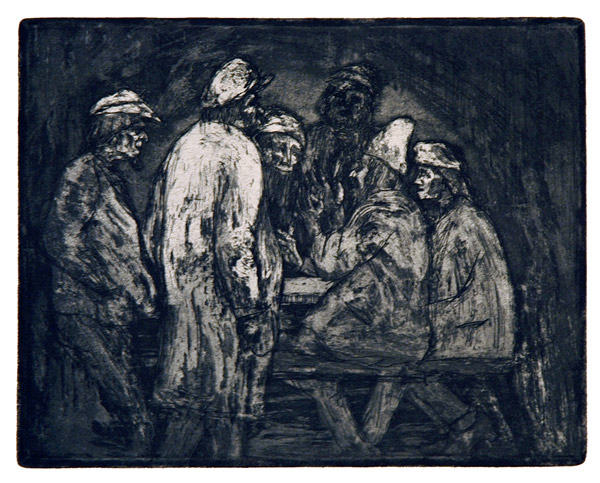 |
|
|
|
Emil Nolde (German, 1867-1956), Tischgesellschaft / Dinner party (Schieffler and Mosell 38 iv, Davis-Riffkind 2113). Original etching on wove paper, 1906. A beautiful impression of this dark and mysterious work from the beginning of Nolde's career as an expressionist. Published in the 1907 issue of Zeitschrift fur bildende Kunst n.s. 19, n. 2. With the printed text TISCHGESELLCHAFT below the etching. Image size: 151x190mm. Price: SOLD.
|
|
|
|
|
|
 |
|
|
|
Rudolf Schlichter (German, 1890-1955), Street Scene. Ink and wash on brown laid paper, 1935. Signed and dated in pen lower right. Schlichter was a friend of Georg Grosz, whose 1929 painting of him at work in his studio is reproduced in Bertrand Lorquin, Annette Vogel, and Hans Wilderotter, Allemagne, les année noires (Paris: Galliard, 2007), a wonderful exhibition catalogue that accompanied a show of the works of Otto Dix, Max Beckmann, Georg Grosz, and Ludwig Meidner at the Musée Maillol in Paris. Schlichter was also a close friend of Bertolt Brecht (whose portrait he painted), Kurt Weill, and Lotte Lenya. He was imprisoned by the Nazis for ridiculing them in a large painting. After his release, he painted an even larger attack upon the regime. I'm not sure how he survived. Image size: 321x220mm. Price: Please call or email for current pricing information.
|
|
|
|
|
|
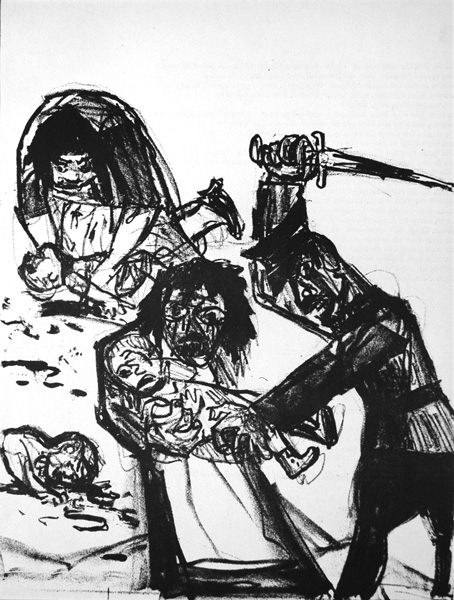 |
|
|
|
Otto Dix (German, 1891-1969), Der Kindermord zu Bethlehem / The Slaughter of the Innocents (Karsch 238). Original lithograph, 1960. 2000 impressions published in Das Evangelium nach Matthäus. Dix portrays Herod's soldiers in the uniform of Hitler's SA Troops. Image size: 293x225mm. Price: Please call or email for current pricing information.
|
|
|
 |
|
|
|
Alfons Graber (Austria, 1901-1990), Caini and Abel. Oil painting on Masonite board, c. 1930. Graber was born in Steinach, Austria. He studied art at the Munchner Kunstakademie with Becker-Gundahl and at the Akademie der bildenden Künste in Vienna, first with Ferdinand Andri, then with Alois Delugessen in the Meisterschule. He was a Professor at Innsbruck from 1931-52. Some of his works are collected in the Alfons Graber Museum in Steinach am Brenner, Tirol. Graber's work, which won several prizes during the 1930s, has been described as "Neo-Baroque," a term one could employ to describe much Expressionist painting at a time when Expressionism was much out of favor in right-wing circles. Kokoschka, who had fled Austria first for Prague and then England during the Nazi years, seems to have been a powerful influence on Graber. Signed "A. Graber" lower right. Image size: 398x305mm. Price: Please call or email for current pricing information.
|
|
|
|
|
|
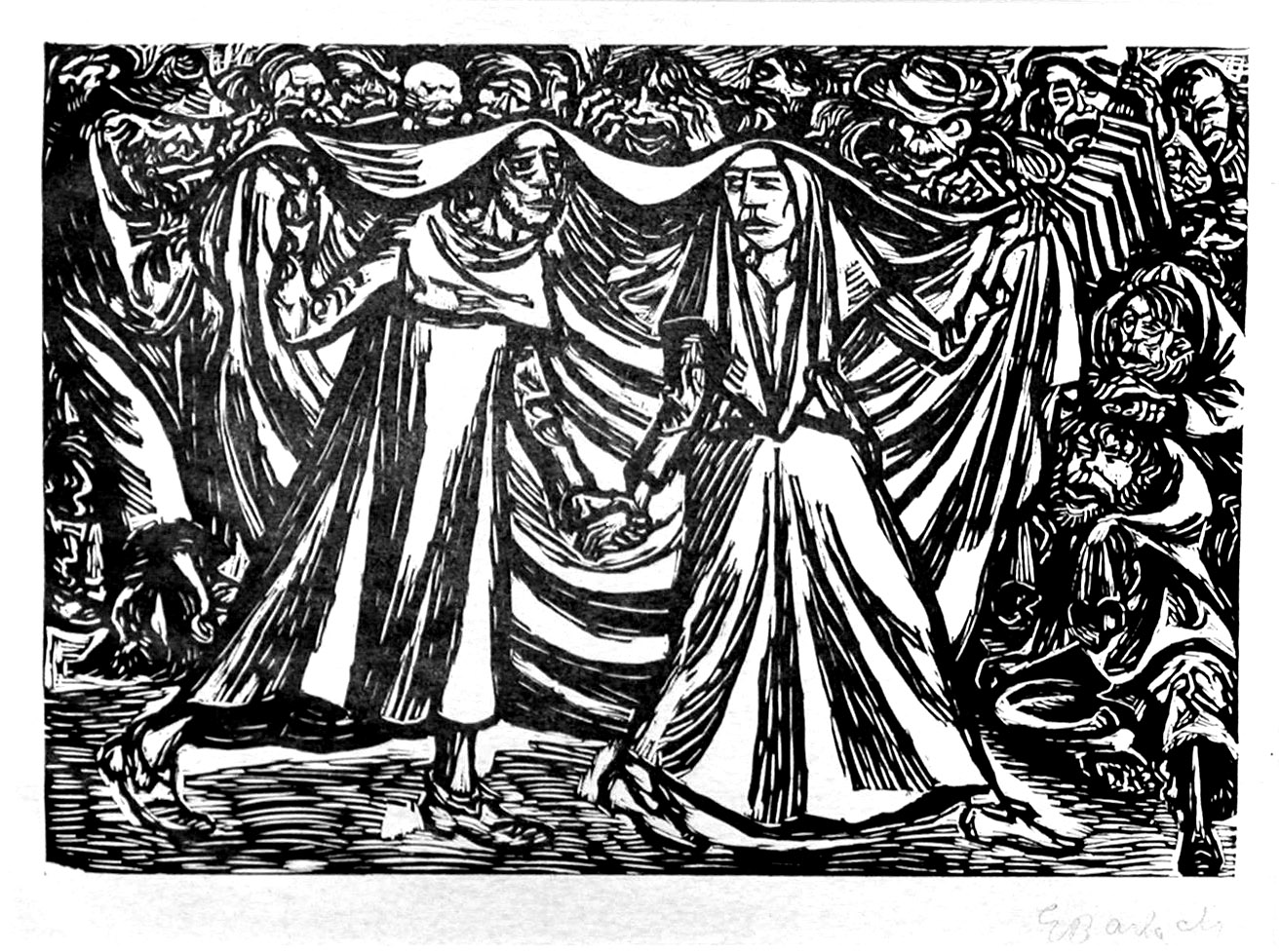 |
|
|
|
Totentanz 2 / TheDance of Death 2 (Schult 168 Davis-Rifkind 98: 4). Original woodcut, 1920-21. Published in Die Wandlungen Gottes / The Transformations of God, plate 4. 121 impressions on japon signed in the lower right corner. Image size: 257x359mm. Price: Please call or email for current pricing information.
|
|
|
|
|
|
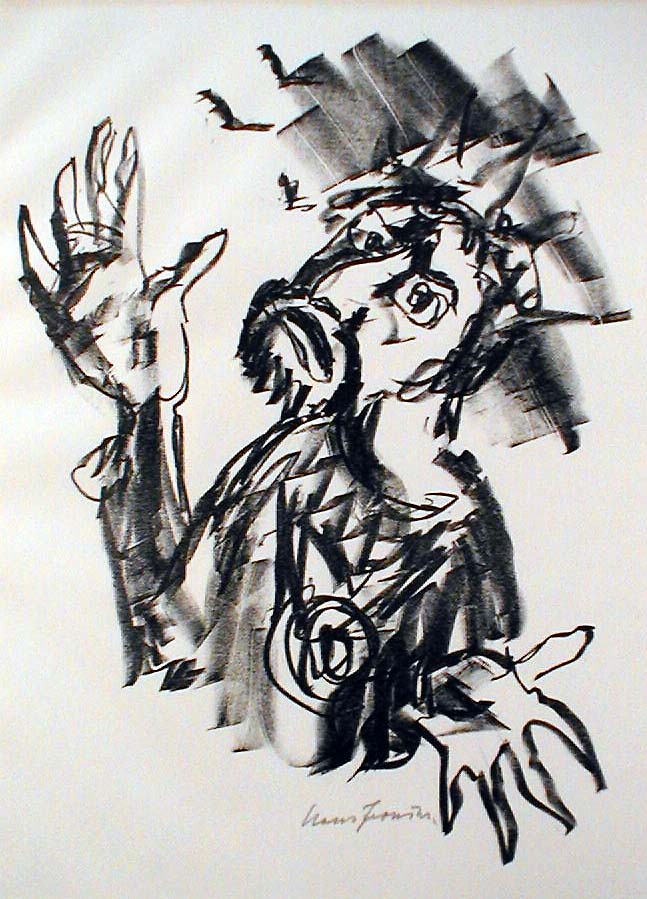 |
|
|
|
Hans Fronius (Austrian, 1903-after 1986), Saul realizes that David has spared him. Original lithograph, c. 1955. Edition: 200 signed impressions for the portfolio Saul und David in der Höhle. Otto Benesch, one of the most important art historians of the twentieth century, has called Hans Fronius "the most significan Austrian illustrator since Alfred Kubin" (cited Maria Buchsbaum in Hans Fronius: Paraphrasen / Paraphrases with an introductory essay by Dieter Ronte [Stuttgart: Klett-Cotta, 1986] on the occasion of an exhibition devoted to Fronius' late works at the Museum of Modern Art in Vienna). Fronius has been the subject of more than 200 one-person exhibitions at the Albertina (Vienna, 1952, organized by Benesch, and 1972), Mexico City (1957), The Venice Biennale (1957), the National Library, Madrid (1967), the Gutenberg Museum (Mainz, 1968), the Staatsmuseum, Luxemboug (1976), the Royal National Library, Brussels (1976), the Bibliothèque Nationale, Paris (1977), Centre Pompidou, Paris (1984), and many others. He has been awarded numerous prizes and honors, including the Grosser Österreichischer Staatspreis (1966), the Gutenberg Prize awarded by the city of Leipzig (1981), and the Lovis Corinth Prize of the Federal Republic of Germany (1983). Image size: 535x377mm. Price: Please call or email for current pricing information.
|
|
|
|
|
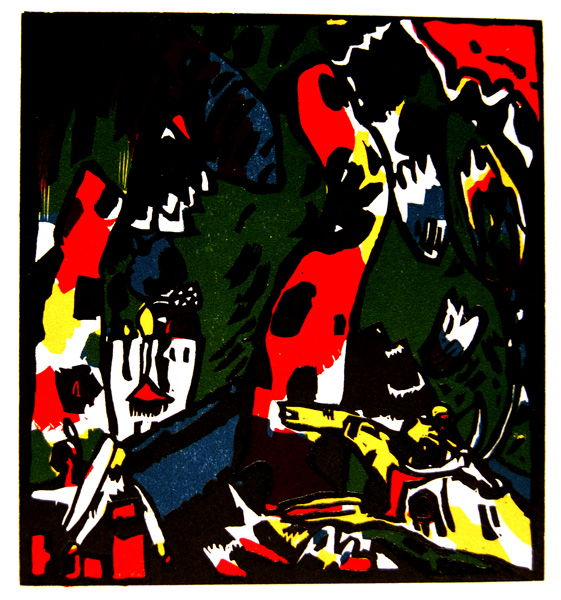 |
|
|
|
Wasily Kandinsky (Russian, 1866-1944), The Archer (Roethel 79). Original color woodcut, 1908-1909. Edition: 60 impressions for the deluxe edition of Der Blaue Reiter almanac + c. 1200 proofs printed in XXe Siecle in 1938 under Kandinsky's supervision. Another impression of this print (also from the 1938 XXe Siecle edition) is illustrated in Vivian Endicott Barnet, Kandinsky at the Guggenheim (NY: Solomon R. Guggenheim Museum, 1983), p. One of Kandinsky's richest woodcuts. Image size: 164x153mm. Price: Please call or email for current pricing information.
|
|
|
|
|
|
 |
|
|
|
Wasily Kandinsky (Russian, 1866-1944), Zwei Reiter vor Rot / Two riders on a red background (Roethel 95, Davis-Rifkind 1368: 1). Original color woodcut, 1911. Edition: 345 impressions signed in the block with the monogram for Klange / Sounds (1913). C. 1200 proofs printed in XXe Siecle in 1938 under Kandinsky's supervision. Image size: 123x190mm. Price: Please call or email for current pricing information.
|
|
|
|
|
|
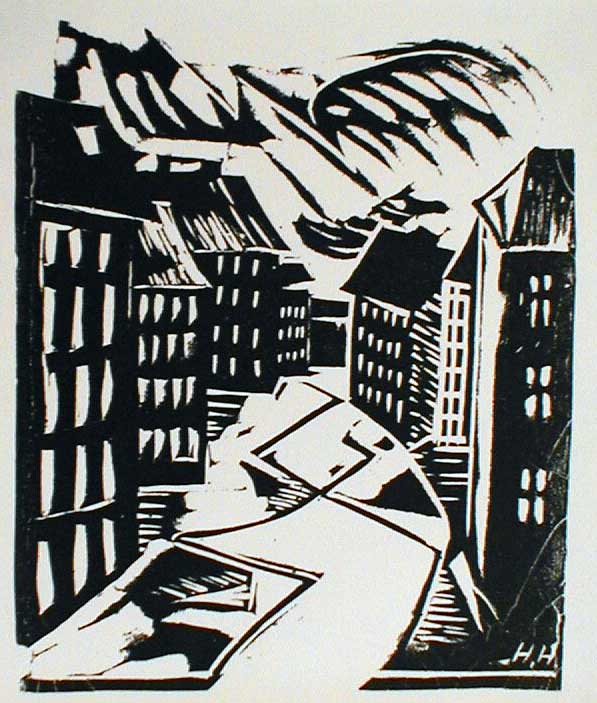 |
|
|
|
Hannah Hoch (German, 1889-1978), Street in Berlin. Original linocut, 1912. 1800 impressions signed in the block. Image size: 206x171mm. Price: Please call or email for current pricing information.
|
|
|
|
Spaightwood Galleries, Inc.
To purchase, call us at 1-800-809-3343 (1-508-529-2511 in Upton MA & vicinity) or send an email to spaightwood@gmail.com.
We accept AmericanExpress, DiscoverCard, MasterCard, and Visa.
We also accept wire transfers and paypal.
For directions and visiting information, please call. We are, of course, always available over the web and by telephone (see above for contact information). Click the following for links to past shows and artists. For a visual tour of the gallery, please click here. For information about Andy Weiner and Sonja Hansard-Weiner, please click here. For a list of special offers currently available, see Specials.
All works are sold with an unconditional guarantee of authenticity (as described in our website listing).
Copyright 2004-2017, Spaightwood Galleries, Inc.
Go back to the top of this page.
Visiting hours: Saturday 10:00 am to 5:00 pm and Sunday noon to 6:00 pm and other times by arrangement.
Please call to confirm your visit. Browsers and guests are welcome.
|
|
|
|
|
|
|
|
|
|
|
|
|
|
|
|
|
|
|
|
|
|
|
|
|
|
|
|
|
|
|
|
|
|
|
|
|
|
|
|
|
|
|
|








